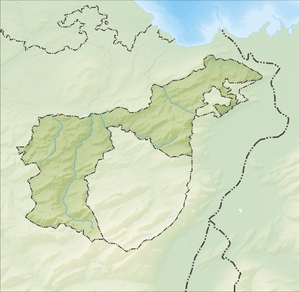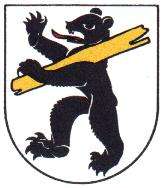Herisau
| Herisau | ||
|---|---|---|
 | ||
| ||
 Herisau | ||
|
Location of Herisau   Herisau Herisau (Canton of Appenzell Ausserrhoden) | ||
| Coordinates: 47°23′N 9°16′E / 47.383°N 9.267°ECoordinates: 47°23′N 9°16′E / 47.383°N 9.267°E | ||
| Country | Switzerland | |
| Canton | Appenzell Ausserrhoden | |
| District | n.a. | |
| Government | ||
| • Executive |
Gemeinderat with 7 members | |
| • Mayor |
Gemeindepräsident (list) Renzo Andreani SVP/UDC (as of February 2014) | |
| • Parliament |
Einwohnerrat with 31 members | |
| Area[1] | ||
| • Total | 25.2 km2 (9.7 sq mi) | |
| Elevation | 771 m (2,530 ft) | |
| Population (Dec 2016[2]) | ||
| • Total | 15,730 | |
| • Density | 620/km2 (1,600/sq mi) | |
| Postal code | 9100 | |
| SFOS number | 3001 | |
| Surrounded by | Degersheim (SG), Flawil (SG), Gossau (SG), Hundwil, St. Gallen (SG), Schwellbrunn, Stein, Waldstatt | |
| Website |
www SFSO statistics | |
Herisau is a municipality of the canton of Appenzell Ausserrhoden in Switzerland. It is the seat of the canton's government and parliament; the judicial authorities are situated in Trogen.
The central hamlet and the houses around the central square, the Protestant church of 1580, the houses Wetter and zur Rose (both 1737), the hamlet Schwänberg and the government building with the state archive are listed as heritage sites of national significance.[3]
Together with other Alpine towns Herisau engages in the Alpine Town of the Year Association for the implementation of the Alpine Convention to achieve sustainable development in the Alpine Arc. Herisau was awarded Alpine Town of the Year 2003.
History
Herisau was first mentioned in 837 as Herinisauva,[4] and its church is mentioned in 907. In 1084 Herisau was destroyed as part of battles around the monastery in St. Gallen. In 1248 and 1249 the town was destroyed again, this time by the monastery to establish loyalty. In 1401 Herisau joined an alliance with other places in Appenzell as part of the Appenzell Wars.
Between 1517 and 1518 Herisau managed to buy itself free from the monastery. The town hall was built in 1601. In 1606 the town was largely destroyed by a fire. In 1648 Schwellbrunn separated and became an independent village. Between 1798 and 1803 Herisau was the capital of the canton Säntis.
Geography
Herisau has an area, as of 2006, of 25.2 km2 (9.7 sq mi). Of this area, 56.8% is used for agricultural purposes, while 27.1% is forested. Of the rest of the land, 15.5% is settled (buildings or roads) and the remainder (0.6%) is non-productive (rivers, glaciers or mountains).[5]
The municipality is located in the former District of Hinterland. It is located at the crossing point of two major routes through the region, the St. Gallen-Toggenburg road and the Gossau-Appenzell road. In addition to being the capital of the half canton, about one-third of the population of the entire half canton lives in Herisau.[4] It consists of the village of Herisau and scattered hamlets as well as bedroom communities and industrial sections. Before 1648 it controlled about twice the land area as is currently part of the municipality. Until 1648 Schwellbrunn was part of the municipality and until 1720, Waldstatt was part of Herisau.
Demographics
Herisau has a population (as of 2008) of 15,527, of which about 17.9% are foreign nationals.[6] Over the last 10 years the population has decreased at a rate of -5.2%. Most of the population (as of 2000) speaks German (87.0%), with Serbo-Croatian being second most common ( 3.8%) and Italian being third ( 3.4%).[5]
As of 2000, the gender distribution of the population was 49.6% male and 50.4% female.[7] The age distribution, as of 2000, in Herisau is; 1,194 people or 7.5% of the population are between 0–6 years old. 1,775 people or 11.2% are 6-15, and 835 people or 5.3% are 16-19. Of the adult population, 945 people or 6.0% of the population are between 20–24 years old. 4,760 people or 30.0% are 25-44, and 3,831 people or 24.1% are 45-64. The senior population distribution is 1,702 people or 10.7% of the population are between 65–79 years old, and 840 people or 5.3% are over 80.[7]
In the 2007 federal election the FDP received 76.7% of the vote.[5]
The entire Swiss population is generally well educated. In Herisau about 66.2% of the population (between age 25-64) have completed either non-mandatory upper secondary education or additional higher education (either university or a Fachhochschule).[5]
Historical population

The historical population is given in the following table:[4]
| year | population | Swiss Citizens | % German Speaking | % Protestant | % Roman Catholic |
|---|---|---|---|---|---|
| 1667 | 3,021 | ||||
| 1734 | 4,816 | ||||
| 1780 | 5,933 | ||||
| 1813 | 6,863 | ||||
| 1830 | 7,014 | ||||
| 1850 | 8,387 | 8,189 | 97.1% | 2.9% | |
| 1870 | 9,705 | 9,481 | 92.9% | 6.2% | |
| 1888 | 12,937 | 12,082 | 98.9% | 87.7% | 12.0% |
| 1900 | 13,497 | 12,426 | 98.1% | 84.9% | 14.7% |
| 1910 | 15,336 | 13,550 | 95.0% | 81.4% | 18.0% |
| 1930 | 13,599 | 12,784 | 98.4% | 82.8% | 16.6% |
| 1950 | 13,407 | 12,819 | 97.6% | 80.6% | 18.6% |
| 1970 | 14,597 | 12,128 | 86.0% | 66.3% | 31.3% |
| 1990 | 15,624 | 12,731 | 84.6% | 55.3% | 34.1% |
| 2000 | 15,882 | 12,535 | 87.0% | 48.3% | 32.1% |
Weather
Herisau has an average of 154 days of rain per year and on average receives 1,413 mm (55.6 in) of precipitation. The wettest month is July during which time Herisau receives an average of 167 mm (6.6 in) of precipitation. During this month there is precipitation for an average of 13.9 days. The month with the most days of precipitation is May, with an average of 15.3, but with only 142 mm (5.6 in) of precipitation. The driest month of the year is February with an average of 82 mm (3.2 in) of precipitation over 13.9 days.[8]
Economy
Herisau is located in the centre of eastern Switzerland. As early as 1537 it established itself as an important centre of trade and commerce.
Herisau has an unemployment rate of 2.01%. As of 2005, there were 340 people employed in the primary economic sector and about 115 businesses involved in this sector. 2,959 people are employed in the secondary sector and there are 189 businesses in this sector. 4,505 people are employed in the tertiary sector, with 651 businesses in this sector.[5]
Sport
SC Herisau plays in the Swiss 1. Liga.
Notable residents
- Johannes Baumann, (1874-1953), member of the Swiss Federal Council (1934–1940)
- Hans-Rudolf Merz, (born 1942), member of the Swiss Federal Council (2003–2010)
- Paul Giger (born 1952), violinist and composer
- Jonas Hiller, (born 1982), National Hockey League goaltender
- Hermann Rorschach, (1884-1922), psychologist
- Nikolaus Senn (1926–2014), former co-director of Schweizerische Bankgesellschaft
- Theodoros Orfanidis (born 1975), Conductor - Born in Herisau

- Johannes Zollikofer (1633-1692), priest (here from 1666 to his death)
- Robert Walser (1878-1956), German speaking Swiss writer
- Markus Zürcher (1946-2013), Swiss visual artist, representatives of conceptual art
- Paul Ramsauer (1919-2016), Executive for W.R. Grace
- Ruth Erat (born 1951), Swiss teacher, writer, painter and politician
- Jörg Eberle (born 1962), Swiss ice hockey player
- Mathias Rusterholz (born 1971), Swiss athlete, holds since 1996 the Swiss record in the 400 meter race
- Beat Forster (born 1983), Swiss ice hockey player, currently playing for NLA Club HC Davos
References
- ↑ Arealstatistik Standard - Gemeindedaten nach 4 Hauptbereichen
- ↑ Swiss Federal Statistical Office - STAT-TAB, online database – Ständige und nichtständige Wohnbevölkerung nach institutionellen Gliederungen, Geburtsort und Staatsangehörigkeit (in German) accessed 30 August 2017
- ↑ Swiss inventory of cultural property of national and regional significance (1995), p. 55.
- 1 2 3 Herisau in German, French and Italian in the online Historical Dictionary of Switzerland.
- 1 2 3 4 5 Swiss Federal Statistical Office Archived 2016-01-05 at the Wayback Machine. accessed 15-Sep-2009
- ↑ Brief Statistics for the half-canton Archived 2011-06-12 at the Wayback Machine. (in German) accessed 15 September 2009
- 1 2 Appenzell Outer Rhodes website Archived 2009-09-13 at the Wayback Machine. (in German) accessed 15 September 2009
- ↑ "Temperature and Precipitation Average Values-Table, 1961-1990" (in German, French, and Italian). Federal Office of Meteorology and Climatology - MeteoSwiss. Archived from the original on 27 June 2009. Retrieved 8 May 2009. , the weather station elevation is 700 meters above sea level.
External links
| Wikimedia Commons has media related to Herisau. |
- http://www.herisau.ch (in German) official website
- Herisau in German, French and Italian in the online Historical Dictionary of Switzerland.
